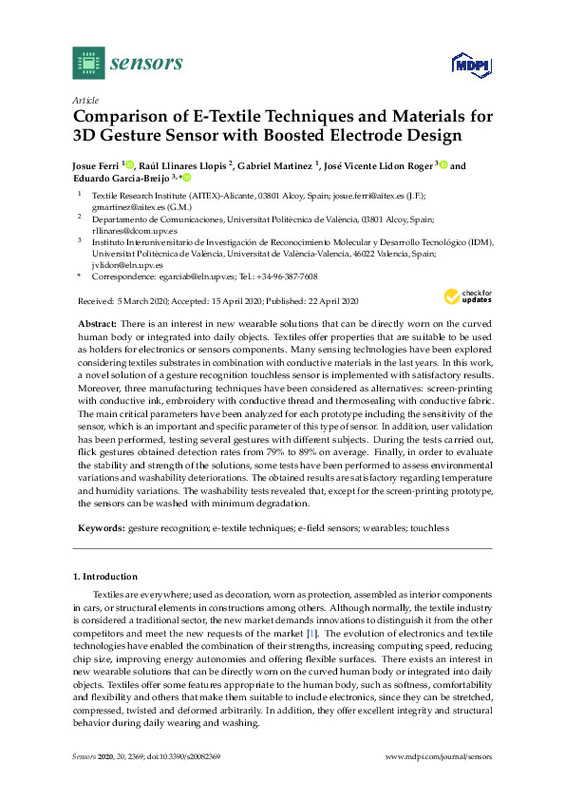JavaScript is disabled for your browser. Some features of this site may not work without it.
Buscar en RiuNet
Listar
Mi cuenta
Estadísticas
Ayuda RiuNet
Admin. UPV
Comparison of E-Textile Techniques and Materials for 3D Gesture Sensor with Boosted Electrode Design
Mostrar el registro sencillo del ítem
Ficheros en el ítem
| dc.contributor.author | FERRI PASCUAL, JOSUÉ
|
es_ES |
| dc.contributor.author | Llinares Llopis, Raúl
|
es_ES |
| dc.contributor.author | Martinez, G.
|
es_ES |
| dc.contributor.author | Lidon-Roger, Jose V.
|
es_ES |
| dc.contributor.author | Garcia-Breijo, Eduardo
|
es_ES |
| dc.date.accessioned | 2021-11-05T14:12:51Z | |
| dc.date.available | 2021-11-05T14:12:51Z | |
| dc.date.issued | 2020-04 | es_ES |
| dc.identifier.uri | http://hdl.handle.net/10251/176523 | |
| dc.description.abstract | [EN] There is an interest in new wearable solutions that can be directly worn on the curved human body or integrated into daily objects. Textiles offer properties that are suitable to be used as holders for electronics or sensors components. Many sensing technologies have been explored considering textiles substrates in combination with conductive materials in the last years. In this work, a novel solution of a gesture recognition touchless sensor is implemented with satisfactory results. Moreover, three manufacturing techniques have been considered as alternatives: screen-printing with conductive ink, embroidery with conductive thread and thermosealing with conductive fabric. The main critical parameters have been analyzed for each prototype including the sensitivity of the sensor, which is an important and specific parameter of this type of sensor. In addition, user validation has been performed, testing several gestures with different subjects. During the tests carried out, flick gestures obtained detection rates from 79% to 89% on average. Finally, in order to evaluate the stability and strength of the solutions, some tests have been performed to assess environmental variations and washability deteriorations. The obtained results are satisfactory regarding temperature and humidity variations. The washability tests revealed that, except for the screen-printing prototype, the sensors can be washed with minimum degradation. | es_ES |
| dc.description.sponsorship | This work was supported by the Spanish Government/FEDER funds (RTI2018-100910-B-C43) (MINECO/FEDER). The work presented is also funded by the Conselleria d'Economia Sostenible, Sectors Productius i Treball, through IVACE (Instituto Valenciano de Competitividad Empresarial) and cofounded by ERDF funding from the EU. Application No.: IMAMCI/2020/1 | es_ES |
| dc.language | Inglés | es_ES |
| dc.publisher | MDPI AG | es_ES |
| dc.relation.ispartof | Sensors | es_ES |
| dc.rights | Reconocimiento (by) | es_ES |
| dc.subject | Gesture recognition | es_ES |
| dc.subject | E-textile techniques | es_ES |
| dc.subject | E-field sensors | es_ES |
| dc.subject | Wearables | es_ES |
| dc.subject | Touchless | es_ES |
| dc.subject.classification | TEORIA DE LA SEÑAL Y COMUNICACIONES | es_ES |
| dc.subject.classification | TECNOLOGIA ELECTRONICA | es_ES |
| dc.title | Comparison of E-Textile Techniques and Materials for 3D Gesture Sensor with Boosted Electrode Design | es_ES |
| dc.type | Artículo | es_ES |
| dc.identifier.doi | 10.3390/s20082369 | es_ES |
| dc.relation.projectID | info:eu-repo/grantAgreement/AEI/Plan Estatal de Investigación Científica y Técnica y de Innovación 2017-2020/RTI2018-100910-B-C43/ES/DESARROLLO DE PLATAFORMAS DE DETECCION Y TERAPEUTICAS PARA APLICACIONES BIOMEDICAS BASADAS EN DISPOSITIVOS ELECTRONICOS/ | es_ES |
| dc.rights.accessRights | Abierto | es_ES |
| dc.contributor.affiliation | Universitat Politècnica de València. Departamento de Comunicaciones - Departament de Comunicacions | es_ES |
| dc.contributor.affiliation | Universitat Politècnica de València. Departamento de Ingeniería Electrónica - Departament d'Enginyeria Electrònica | es_ES |
| dc.description.bibliographicCitation | Ferri Pascual, J.; Llinares Llopis, R.; Martinez, G.; Lidon-Roger, JV.; Garcia-Breijo, E. (2020). Comparison of E-Textile Techniques and Materials for 3D Gesture Sensor with Boosted Electrode Design. Sensors. 20(8):1-19. https://doi.org/10.3390/s20082369 | es_ES |
| dc.description.accrualMethod | S | es_ES |
| dc.relation.publisherversion | https://doi.org/10.3390/s20082369 | es_ES |
| dc.description.upvformatpinicio | 1 | es_ES |
| dc.description.upvformatpfin | 19 | es_ES |
| dc.type.version | info:eu-repo/semantics/publishedVersion | es_ES |
| dc.description.volume | 20 | es_ES |
| dc.description.issue | 8 | es_ES |
| dc.identifier.eissn | 1424-8220 | es_ES |
| dc.identifier.pmid | 32331268 | es_ES |
| dc.identifier.pmcid | PMC7219339 | es_ES |
| dc.relation.pasarela | S\408461 | es_ES |
| dc.contributor.funder | Generalitat Valenciana | es_ES |
| dc.contributor.funder | AGENCIA ESTATAL DE INVESTIGACION | es_ES |
| dc.contributor.funder | European Regional Development Fund | es_ES |








